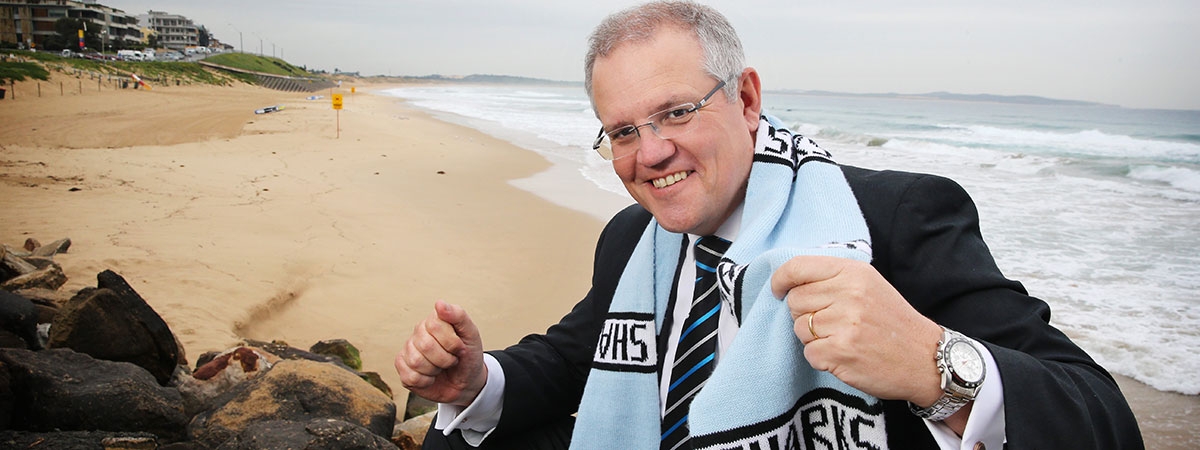WHO WANTS TO BE A BATTLER?
Scott Morrison is the descendant of convicts and the son of a copper. He sympathises with both the swagman and the squatter. In this way, “ScoMo” perfectly encapsulates the identity crisis at the heart of Australia.
“I love Australia,” Morrison told the Menzies Research Centre in 2018. “Who loves Australia? Everyone. We all love Australia. Of course we do. But do we love all Australians? That’s a different question, isn’t it? Do we love all Australians? We’ve got to … Whether they’ve become an Australian by birth ten generations ago, when my ancestors came – not by choice, but in chains, rocked up in 1788 – they did alright.”
After serving in the army, Scott’s old man, John, joined the NSW Police Force and played rugby union for Randwick. Sydney was a city riven with political and religious divisions. The working class even had their own sport: rugby league. In 1908, Irish-Catholic larrikins had protested against the lack of match payments by joining the rival code. Rugby union players from the North Shore and the eastern suburbs were known as “rah-rahs.” Rugby league players from working-class suburbs like Redfern and Balmain were nicknamed “mungos,” short for mongrels.
“Rugby league was the bastard child that got away from rugby union,” Peter Beattie – the former Labor premier of Queensland – once told me. “It fitted within that whole Ned Kelly psychology of rebellion.” The blacksmiths and boilermakers paid to play rugby league were philosophically kindred with bushrangers, trade unions and the Vatican. The stockbrokers and doctors who played rugby union for free were allied with elite private schools, Protestantism and Buckingham Palace.
Scott Morrison was raised on the side of the toffs, not the battlers. His dad, John, and mum, Marion, were salt-of-the-earth Presbyterians, à la Robert Menzies. They belonged to the Liberal Party’s moral middle class. The Morrisons popped out two sons – Alan and Scott – before dropping into the newly merged Uniting Church in Bondi Junction. John was the leader of the Boys’ Brigade and Marion the leader of the Girls’ Brigade. What did the Christian copper’s younger son do for fun? He signed up to a theatre group with Mum and Dad and starred in a TV ad for cough drops: “Vicks’ll lick a ticklin’ throat.”
Scott Morrison was an extremely obedient drama kid who played rugby union like his rah-rah father. “Rugby [union] will always be my game,” he tweeted in 2012. Yet the two defining themes of Morrison’s youth are a precocious puritanism and the blind faith that he comes from humble suburban beginnings. He recalls his childhood as being “run-of-the-mill” and “nothing out of the ordinary.” “Bronte was a lot different back then than it is today,” Morrison told The Australian before the 2017 budget.
The beachside suburb of Bronte might appear second-rate and far away from everything if you’ve got mates in Double Bay, where Morrison might seem like Darryl Kerrigan compared to Malcolm Turnbull. But Morrison’s upbringing was suspiciously close to that of the inner-city elite. He played the saxophone at Sydney Boys High, a selective public school next to the SCG and a member of the prestigious Athletic Association of the Great Public Schools of New South Wales (AAGPS). The AAGPS was an Antipodean outcrop of the British aristocracy. Morrison made the 1st VIII for rowing and 1st XV for rugby union, two leisure activities of the affluent. On bore-watered GPS ovals, “Scotty-Mo” possibly crossed paths with Barnaby Joyce, a sullen boarder across the harbour at Riverview, and James Packer, a cricket fanatic at Cranbrook. “I learned that you don’t have to be rolling in money to be happy,” Morrison told The Australian, “as long as you’re all together and helping each other.”
The eastern suburbs of Sydney, where Morrison grew up, were arguably the most concentrated pocket of prosperity in one of the world’s richest countries. Sydney Boys High might not have been Riverview or Cranbrook. Bronte wasn’t Bellevue Hill. Still, it wasn’t Blacktown, let alone Broken Hill. By the same token, Scott’s father wasn’t exactly Kerry Packer. But John Morrison was an extremely well-connected public servant who sat on Waverley Council for two decades. In 1986, John served simultaneously as mayor of Waverley and as a chief inspector of the NSW Police Force. The “modest” house that Morrison’s parents inherited from a widowed aunt – where Scotty-Mo stoically shared a bedroom with his older brother, Alan, until high school – sold for $1.5 million in 2001. Morrison felt like a suburban battler relative to the children of multi-millionaires, not realising that his close proximity to this cult of blind privilege was itself a geographical miracle. It is one thing to be lucky, and another to dedicate your life to hoarding luck from those who need some.
CONTINUE READING
This is an extract from Lech Blaine's Quarterly Essay, Top Blokes: The Larrikin Myth, Class and Power. To read the full essay, subscribe or buy the book.
ALSO FROM QUARTERLY ESSAY












